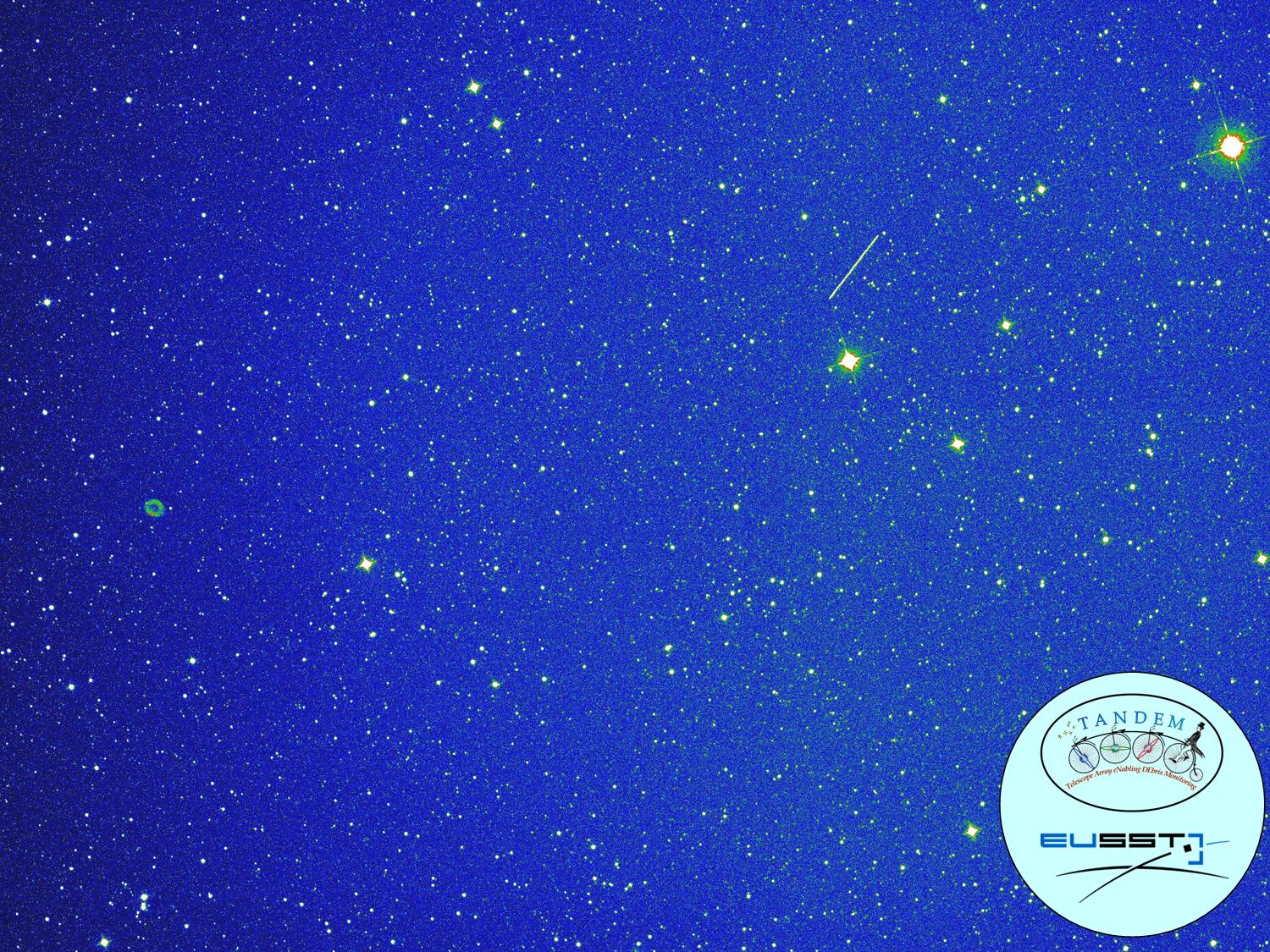
A (finally) relaxed and smiling “family picture” of the INAF team (left), just after a successful ending of the TANDEM installation at the Loiano Observatory on June 27, 2023. From left to right: Roberto Gualandi, Roberto Di Luca, Albino Carbognani, Sergio Mariotti, Ivan Bruni (in front) and Alberto Buzzoni (behind). Right panel: TANDEM now flanks the Cassini main telescope.
TANDEM stands for Telescope Array eNabling DEbris Monitoring and is a new instrumental addition to the “G.D. Cassini” 152 cm telescope at the OAS premises in Loiano. Alberto Buzzoni is the PI of the project, which has been carried out in the framework of the European Space Surveillance and Tracking (SST) activities for OCIS/EU-SST. The instrument has been manufactured by ADS Intl. in Annone Brianza (LC) and is installed and set in operation since June 2023.
It consists of a battery of four customized AG14 f/3 Newtonian telescopes, built by ORION Ltd (UK), each with aperture 35 cm. TANDEM shares part of the Cassini pointing capabilities in a sort of mega-binoculars. In particular, the fixed anchoring at the Cassini declination-axis flange, makes the telescope combo to share the hour angle (and correspondingly the celestial Right Ascension, RA) with Cassini. On the contrary, Declination pointing may be decoupled, as TANDEM can move the four telescopes according to its own declination axis, which allows the telescope set to span the full range from Dec -30o to +90o on sky. In addition, and most importantly, one has to consider that each of the TANDEM telescopes is allowed a supplementary and independent steering by ±10o around the common pointing direction (both RA and Dec) by means of individual tilt/spin actuators onboard.
Though not reaching the full Cassini aperture, when combined, these telescopes could conveniently match the collecting area of a monolithic mirror of 70 cm in diameter sporting an even faster focal ratio of f/1.5 such as to reach magnitude V~18.5 in 2 min exposures or V~20 in 30 min. Each telescope is equipped with a Moravian C4-16000 camera with a motorized and remotely controlled filter wheel which implements the BVRcIc Johnson-Cousins photometric system. The camera carries onboard a front-illuminated Grade 1 GSense 4040 (4096×4096 px) monochrome CMOS with electronic shutter. The CMOS pixel technology includes a microlens array (CMT). The detector is cooled down to 35o C below ambient by means of a thermoelectric (Peltier) module. A 9 μm pixel size provides 17 Mpx imagery at 16 bit counting depth across a 2ox2o wide field of view (FOV) fully corrected for coma aberration via a 4” Wynne corrector. The latter was ad-hoc manufactured by Tecnottica Consonni srl, in Calco (LC). The platescale at CMOS is 1.75 arcsec/px.
The TANDEM operational characteristics allow the observer to “trade-off” angular and sensitivity performances, as he/she can either use the instrument at its best magnitude sensitivity by converging the four telescopes on the same 2ox2o FOV or, in alternative, fully exploit the wider angular coverage on sky by steering each telescope in a different direction such as to mosaic four adjacent fields, covering a 4ox4o FOV, or simultaneously targeting four sparse fields up to 20o apart for up to 16 square deg. A number of pre-defined pointing patterns is made available by the system and other user-defined configurations can, in case, be easily implemented.

A TANDEM field around the gorgeous planetary nebula M57, in Lyra (the small green donut to the left of the frame), in a 10 sec exposure of June 29, 2023. Note the bright trail in the upper right corner of the image, left by a space debris then identified with the Ariane 5 rocket booster (NORAD 41863) which delivered in MEO orbit the GPS satellite Galileo 15, in 2016.
Though within the framework of the due institutional activity for SST/SSA services, a fraction of TANDEM observing time along the current commissioning period (2023-25) may be available for external collaborations with our science group upon suitable MoU conditions to be negotiated.
Among the many envisaged fields of astrophysical interest, that could usefully take advantage of TANDEM special capabilities, the following cutting-edge science cases (a not necessarily exhaustive list) could be mentioned for their relevance:
- Search for optical counterparts of GRB and FRB events and gravitational wave (GW) flashes
- Search for exo-planets with the occultation method
- OSETI (search for interstellar laser signals) surveys, with hyper-fast photometry
- Search for Main Belt, NEO and PHA (Potentially Hazardous Asteroids) objects
- Search for “interstellar intruders” (comets and asteroids like 1I/’Oumuamua or 2I/Borisov)
- Study of meteoric impacts on the Moon
- Study of stellar streams in the Galaxy (and other archeo-astronomy applications)
- Wide-field survey of extragalactic star clusters and variable stars in Local Group galaxies
- Study of serendipitous celestial transients
The original TANDEM research team, led by Alberto Buzzoni, included:
- Ivan Bruni, Silvia Galleti and Roberto Gualandi: night operations and technical support
- Albino Carbognani and Giovanna Stirpe: EU-SST operational services and data quality check
- Fausto Cortecchia, Emiliano Diolaiti, Matteo Lombini and Laura Schreiber: opto-mechanical support
- Roberto Di Luca: IT support
TANDEM is currently (2025) operated by the OAS Space Situational Awareness (SSA) group, including:
- Manuel Barbetta, Antonio De Blasi, Silvia Galleti and Roberto Gualandi: night operations and technical support
- Albino Carbognani and Giovanna Stirpe:EU-SST operational services
Reference Links:
- Website of the European EU-SST Consortium
- Homepage of the OAS SSA Group
- TANDEM at the Alberto Buzzoni’s Space Science homepage
- TANDEM’s research paper: Buzzoni, A. et al. 2025. “The TANDEM Project as a Pilot Case for Wide-field Telescope Arrays.” The Astronomical Journal 169, 53. doi:10.3847/1538-3881/ad93a2
- SST relevant references in the Piano Triennale INAF 2022-24 (Sec. 5)
- The INAF portal “Under Space Surveillance”
